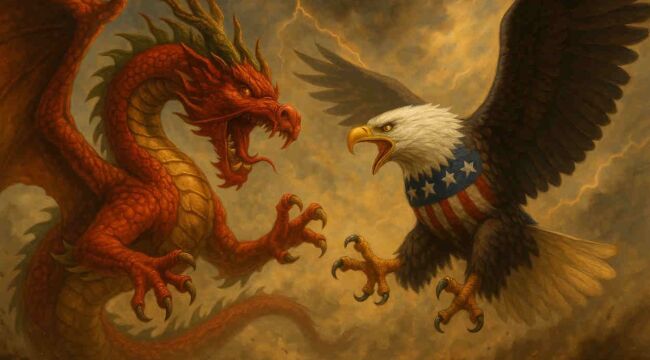The Mar-a-Lago Accord Targets China
In 1985 a secret meeting took place at the Plaza Hotel in Manhattan. James Baker, U.S Treasury Secretary, told the assembled lords of finance, “The dollar is killing us.”
The strong dollar was indeed a problem. Manufacturing jobs were being shipped overseas to Japan, Germany, and elsewhere at a disturbing pace.
You see, when the dollar is too strong, this hurts American exports. It becomes too expensive for foreigners to buy our goods.
So U.S. leaders were determined to weaken the dollar. The goal was to improve conditions for U.S. exporters.
Assembled at the Plaza Hotel were Japan’s Finance Minister Noboru Takeshita, Germany’s Gerhard Stoltenberg, France’s Pierre Bérégovoy, and the U.K.’s Nigel Lawson.
Baker reportedly told the financial leaders, “We need coordinated action. Intervention. And we need it now.”
A plan was hatched. It would become known as the Plaza Accord. The world’s largest economies, Japan, Germany, the UK, and France were essentially strong-armed into strengthening their currencies versus the U.S. dollar.
Kneecapping Japan
Japan was perhaps most affected by this shift in the global monetary world order. Japan had become a towering force in manufacturing. They specialized in electronics and automobiles, and were becoming absolutely dominant.
After the Plaza Accord, the Japanese yen rose dramatically. This temporarily crippled the booming export industry.
In response, Japan cut interest rates and eased monetary conditions. The combination of easing monetary conditions and a strengthening currency created a massive bubble in Japanese real estate and stock markets.
Japan experienced an epic runup in stock and real estate prices, peaking in 1989, 4 years after the Plaza Accord was agreed upon. The Nikkei 225 index rose 3.1x over that period, and real estate prices soared to unprecedented levels.
However, the 1989 crash in Japan was just as epic. The stock market didn’t recover to 1989 levels until 2024.
China Isn’t Japan
In the 1980s, Japan was the rising manufacturing threat. The Plaza Accord was largely an effort to hamper their rise and prevent them from becoming an even more dominant industrial player. In many ways, it worked.
What President Trump is attempting to do to China today is somewhat similar to the Plaza Accord. It is commonly referred to as the Mar-a-Lago Accord, a term coined by our own Jim Rickards.
The thinking is that Trump wants to weaken the dollar and contain the rising threat of China. He wants them to consume more and export less, balancing the global economy.
But the situation with China is different in a number of critical ways compared to Japan of the 1980s.
First, Japan at that point was (and in some ways still is) an occupied country. The U.S. military has a significant presence in Japan, and the country relied on American firepower for defense. It had no true military of its own.
Meanwhile, China is a rising military power. It has nuclear weapons, hypersonic missiles, stealth jets, millions of drones, and a fast-growing naval fleet. For example, China has approximately 203x the shipbuilding capacity of the United States today.
Secondly, China keeps strict control over the flow of money in and out of their country. Japan had a fully open capital account, meaning foreign money could flow in and out with ease. Foreigners could invest as much as they wanted in the currency, stock, and real estate markets.
So to convince China to let its currency strengthen significantly will require quite a bit of leverage. This is why President Trump is ramping up the pressure.
It’s why Scott Bessent says that America may de-list Chinese stocks from American exchanges. And why Chinese-made ships are being charged up to $5.2 million to dock at U.S. ports. It also explains why the U.S. is attempting to convince its allies to threaten to limit trading with China as well.
I understand perfectly well why Trump and his team are going this route. We find ourselves in a serious situation. China is a rising industrial giant, and this trend is only set to accelerate over coming years.
The U.S. has lost its manufacturing might and needs to get it back. However, there are no easy or quick fixes here. All the roads we can choose involve decades of hard work and sacrifice.
Are the American people prepared for such a difficult journey? We shall see…



Comments: